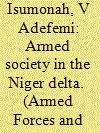| Srl | Item |
| 1 |
ID:
119062


|
|
|
|
|
| Publication |
2013.
|
| Summary/Abstract |
The nonproliferation of weapons agenda was entirely about chemical, biological, radiological, and nuclear weapons because they were seen as the most threatening to human existence and the security of the most powerful countries. Small Arms and Light Weapons (SALW), which have been instrumental to massive destruction of life and property, began to receive a serious attention from world leaders in the 1990s. Consequently, this article is concerned with the problems of controlling the proliferation of SALW in the Niger Delta of Nigeria. It argues that supply implicitly obeys the demand for SALW because it lacks a control factor. The presence of such a factor makes the acquisition of nuclear capability very difficult. Therefore, the effective control of SALW's proliferation would depend not only on controlling local demand factors but also on the presence of a supply control factor.
|
|
|
|
|
|
|
|
|
|
|
|
|
|
|
|
| 2 |
ID:
189353


|
|
|
|
|
| Summary/Abstract |
Violence in post-conflict settings is often attributed to a post-war boom in organized crime, facilitated by the demobilization of armed groups and the persisting weakness of the state. The article argues that this is only one pathway of post-conflict violence. A second causal pathway emerges from the challenges that peace processes can constitute for entrenched local political orders. By fostering political inclusion, the implementation of peace agreements may threaten subnational political elites that have used the context of armed conflict to ally with armed non-state actors. Violence is then used as a means to preserve such de facto authoritarian local orders. We start from the assumption that these two explanations are not exclusive or competing, but grasp different causal processes that may well both be at work behind the assassination of social leaders (líderes sociales) in Colombia since the 2016 peace agreement with the FARC guerrilla. We argue that this specific type of targeted violence can, in fact, be attributed to different, locally specific configurations that resemble the two pathways. The article combines fuzzy-set Qualitative Comparative Analysis with the case studies of the municipalities of Sardinata and Suárez to empirically establish and illustrate the two pathways.
|
|
|
|
|
|
|
|
|
|
|
|
|
|
|
|
| 3 |
ID:
084297


|
|
|